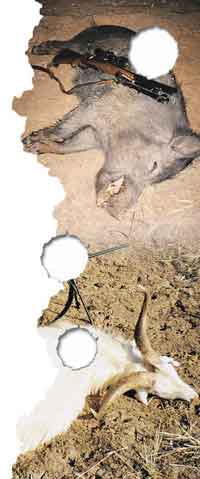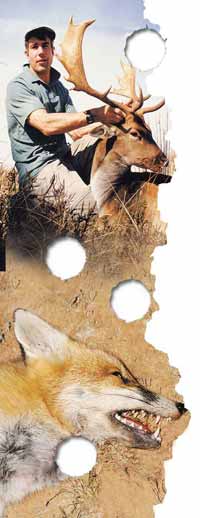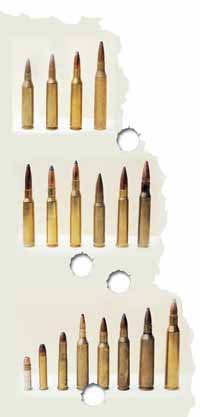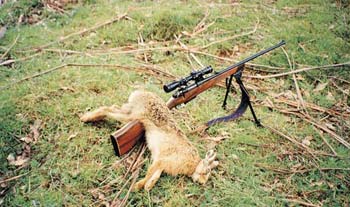Sure-shot cartridges for common Australian game
by Anton Jurasovic
The variety of cartridges used to hunt the common game animals of Australia is enormous and many unusual or uncommon cartridges will do the job very suitably, depending on the species being hunted. Certain cartridges, however, stand out from the crowd - they are the ones most likely to be found out in the field doing what their designers intended.
 It seems that most of the more popular cartridges have a few
characteristics in common: they are readily available, they are usually
comparatively cheap and experience has shown that they are able to do
the job required with little fuss. Many of the more common cartridges
in use today have been around for two or more generations and time has
shown that they do the job adequately when used with accuracy.
It seems that most of the more popular cartridges have a few
characteristics in common: they are readily available, they are usually
comparatively cheap and experience has shown that they are able to do
the job required with little fuss. Many of the more common cartridges
in use today have been around for two or more generations and time has
shown that they do the job adequately when used with accuracy.
These ‘no-nonsense’ cartridges are usually medium-powered rounds, which, because of tolerable recoil and muzzle blast, allow most shooters the best chance of landing their projectile in the vitals of the animal they are hunting. While it is important to make sure that ‘enough gun’ is being used for the specific game animal, it is at least equally important to ensure that the projectile hits where it will be most likely to cause certain and sudden death.
The majority of animals hunted in Australia fall into two size categories: small or medium game. The six most common game species would probably be rabbits, hares, foxes, pigs, goats and the medium-sized deer (fallow, rusa, chital and hog). The first three in the list would be classed as small game, with the remainder in the medium-game class.
Rabbits, hares and foxes are hunted countrywide, with small-game cartridges varying vastly in power and ranging ability. Hares, although nearly twice the size of rabbits, require similar effort to dispatch. Foxes, being larger than hares, are a fair bit more tenacious. The choice of which cartridge to use depends mainly on how far away the hunter plans to be shooting.
The .22 Long Rifle, at ranges of up to about 80m or so, will cleanly take rabbits and hares when used with a good hollowpoint loading. Foxes can also be taken cleanly with this cartridge, particularly when whistled in, however, a maximum range of about 50m should be adopted.
A large proportion of today’s hunters started out hunting small game using the .22 Long Rifle. With practically no recoil, little noise and low cost, it is one of the most popular rounds used on rabbits and other small game, for both beginning shooters and experienced hands.
The next step up in rimfire cartridge power is the .22 Win Magnum. This round has an effective range on rabbits and hares at about 120m and with a useful range of about 90m on fox-sized game it is considerably more effective than the little .22 Long Rifle.
For the small-game hunter who doesn’t want the cost of factory centrefire ammunition or the hassle of reloading, this cartridge would have to be one of the most versatile choices. Ammunition is available in many varieties - from hypervelocity hollowpoints to full metaljacketed versions that cause minimal pelt damage.
 The .22 Hornet, a personal favourite of mine for its low cost when
reloaded and minimal muzzle blast, has been around the block a few
times in its many years. It seems to be having a resurgence in
popularity at the moment, with a fair few new rifles available in this
chambering in recent times. This round is the smallest of the common
centrefire cartridges and with regard to performance, represents a
bridge between the rimfires and the more common and more powerful .22
centrefires. Factory loads boost a 45-grain soft point to about
2650fps, which gives an effective range on small game at about 150 to
160m. Hits at longer ranges can result in clean kills, but shooters
must know the trajectory very well to place their shots accurately, due
to rapidly increasing bullet drop.
The .22 Hornet, a personal favourite of mine for its low cost when
reloaded and minimal muzzle blast, has been around the block a few
times in its many years. It seems to be having a resurgence in
popularity at the moment, with a fair few new rifles available in this
chambering in recent times. This round is the smallest of the common
centrefire cartridges and with regard to performance, represents a
bridge between the rimfires and the more common and more powerful .22
centrefires. Factory loads boost a 45-grain soft point to about
2650fps, which gives an effective range on small game at about 150 to
160m. Hits at longer ranges can result in clean kills, but shooters
must know the trajectory very well to place their shots accurately, due
to rapidly increasing bullet drop.
The remainder of the more common smallgame cartridges are true ‘varmint’ rounds, able to knock over small-game animals at extended ranges of 200m plus. Depending on the cartridge, they are powerful enough and have the inherent potential accuracy to be able to pick off small game from a range of 200 to 350m or as far as the rifleman’s skill can place the projectile where needed.
The .17 Remington, while a very useful all-round small game/varmint round, tends to be used as somewhat of a specialised cartridge, mainly when fox hunting for skins. This cartridge is ideal when negligible pelt damage is required. Its combination of very high velocity with extremely light, frangible projectiles results in very few exit holes in small game.
The .222 and .223 are so similar in performance that it is almost impossible to pick any difference in the field. They are both very good choices for all-round smallgame hunting. Very readily available and noted for tiny groups, these cartridges are probably the most versatile choices for the small-game hunter who wants to be able to partake in ‘varminting’ as well as walkabout pot shooting or stalking.
These rounds are able to do good work on small targets like rabbits, hares and foxes out to 250m and more, depending on the skill of the shooter. Muzzle blast is not excessive and the hunter that wants a multi-purpose smallgame rifle would do well by choosing one of these popular cartridges.
The purist varmint end of small-game cartridges has had huge efforts directed towards developing rounds that achieve maximum velocities and superb accuracy. Many fine wildcats have been developed and tinkered with for decades. New super cartridges appear almost every year - some having amazing ballistics and probably very short barrel lives.
Out of all these creative endeavours, very few varmint wildcat rounds have found legitimacy in the form of being launched as a standard chambering in factory rifles or being available as loaded factory rounds. Two cartridges that stand out in this area are the .22-250 and the .220 Swift. These two rounds have stood the test of time and continue to be among the most popular and available of the specialist longrange, small-game rifles.
The .220 Swift has the edge over the .22-250 in terms of velocity and/or bullet weight, but at the extreme ranges that these cartridges start to show their true potential, it is more the skill of the shooter and the accuracy of the individual rifle/ammunition combination that counts. In the hands of a good shot, these cartridges are able to reach out and score hits at ranges that seem unbelievable to less-experienced shooters.
 For hunters who want the challenge of stretching the range of their
shots at small game to the limit, these cartridges are ideal. The
trade-off for such long-range performance is fierce muzzle blast and
relatively short barrel life.
For hunters who want the challenge of stretching the range of their
shots at small game to the limit, these cartridges are ideal. The
trade-off for such long-range performance is fierce muzzle blast and
relatively short barrel life.
The common medium-game animals of Australia have a live weight of up to about 120kg; however, some pigs exceed this size - although not many. Goats and the various medium-sized deer are thin-skinned, relatively light-boned animals. Pigs, particularly boars, while generally not any harder to put down than deer or goats, are quite thick-skinned around the shoulder region. The gristle pad on a big boar’s shoulder can easily reach 50mm in thickness. In addition to this, there may be a layer of hard-crusted dry mud to penetrate as well, so projectile weight and construction are a major consideration for this species.
When the shot presentation is favourable, it doesn’t take a very powerful firearm to penetrate the chest cavity and do the required damage on any of the common medium-game species. However, in order to be sure that the projectile will achieve the required penetration on quartering or rear shots or when large bones are struck before the vitals, it is prudent to choose a cartridge with enough power, utilising a projectile that has a good balance between expansion and penetration.
Standard cartridges in the 6mm to .30 calibre range will do this admirably and without kicking the shooter so hard as to cause a flinch. There are many rounds that fit the bill. The more common ones include the 6.5 x 55, 7 x 57, .270, .30-30, .308, .303 and .30-06.
All these cartridges have the advantage of readily available factory ammunition and many options of different types of firearms chambered for them. All are good choices, provided sensible projectiles suitable for medium game are used. In the end, individual preference is the decider.
The .30 calibre rounds are possibly a bit more versatile, being able to push heavy bullets more efficiently. All else being equal, the greater frontal area of this calibre also tends to give it the edge in killing ability - but only marginally.
The .270 probably has the flattest trajectory of the group, which is useful at long range, but I can vouch that in the field there is not that much difference when compared to the other standard cartridges listed. I would say that the skill of the rifleman has more of an affect. To gain appreciable ranging ability, it is really necessary to jump up to a Magnum chambering.
 Cartridges in the .25" and 6mm calibre category can be used as true
multi-purpose rounds. They have enough power and penetration with
heavier projectiles to be able to take medium-sized game, yet with
light projectiles are quite capable of being used for varminting. Any
of the mediumgame cartridges discussed in this article can be used on
small game, but they are rarely bought with that use in mind.
Cartridges in the .25" and 6mm calibre category can be used as true
multi-purpose rounds. They have enough power and penetration with
heavier projectiles to be able to take medium-sized game, yet with
light projectiles are quite capable of being used for varminting. Any
of the mediumgame cartridges discussed in this article can be used on
small game, but they are rarely bought with that use in mind.
Cartridges like the .243, 6mm Remington, .257 Roberts and .25-06 are often chosen deliberately for their ability to be used for both small and medium game. With projectiles in the 100-grain range, they are adequate for pigs, goats and the mediumsized deer species. With light projectiles, right down to 60 grains in the case of the .243, they are very flat shooting and able to hold their own in the varminting stakes. In fact, for really long-range work in windy conditions, they often perform better than the hot .22 calibres, albeit with a fair bit more recoil.
It can readily be seen that there are a large variety of standard cartridges suitable for Australia’s small to medium game animals. These no-nonsense cartridges all have various features that make them good choices for certain situations. There is no single, best-choice of cartridge for a given species or class of game. It is up to the individual to decide which cartridge suits their style of hunting and the game they pursue. If the shooter is comfortable with the choice of ammunition, confident in the rifle and able to place their shots accurately, then these standard cartridges will do the job properly and do it with a minimum of fuss.
Captions
Image 1: Top, a good boar taken
with a Lee Enfield .303. A classic example of solid performance from a
standard, no-nonsense cartridge that has been around for 100 years or
so. Bottom, goats are a typical example of a
medium-game animal. Standard cartridges in the 6.5 x 55 to .30-06 range
are ideal for animals of this size range.
Image 2: Top, David Hughes took this trophy
fallow cleanly with a single shot from a .30-06 while hunting with the
author. This cartridge is a good match for the game and suitable
factory ammunition is readily available. Bottom, the business-end of a
fox, which won’t be dining on any more native fauna thanks to the
careful placement of a 40-grain projectile from the author’s .22
Hornet.
Image 3: Top, these four cartridges have the
advantage of being true multi-purpose rounds, able to take medium game
cleanly and also flatshooting enough with light projectiles to be used
for varminting. From left: .243 Win, 6mm Rem, .257 Roberts and .25-06.
Middle, a range of common mediumgame cartridges. From left: 6.5 x 55, 7
x 57, .270 Win .308, .303 and .30-06. Bottom, the full spectrum of
small-game cartridges. From left: .22 Long Rifle, .22 Win Magnum, .22
Hornet, .17 Rem, .222 Rem, .223, .22-250 and .220 Swift.
